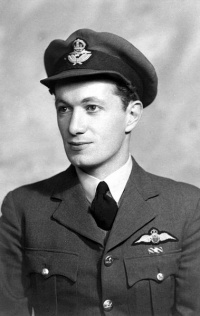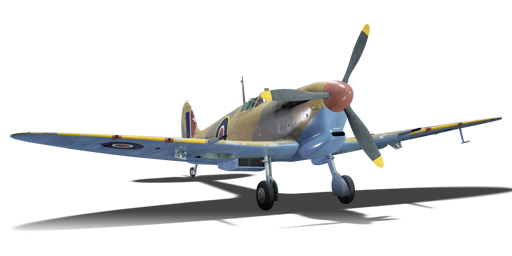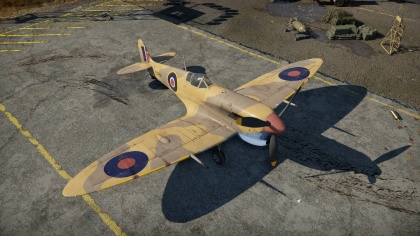Spitfire Mk Vb/trop
Contents
| This page is about the British fighter Spitfire Mk Vb/trop. For other versions, see Spitfire (Family). |
Description
The Spitfire Mk Vb/trop is a rank British fighter
with a battle rating of (AB), (RB), and (SB). It has been in the game since the start of the Open Beta Test prior to Update 1.27.
Having picked up experience from the previous Mk Ia, IIa and IIb, most players will welcome the Spitfire Mk Vb. The Vb sports a new and more powerful Merlin-45 inline compared to the previous Merlin-XII engine giving it an extra 100 horsepower when upgraded, which provides better high altitude performance and faster top speed than the IIb. Unfortunately, the Vb still has similar problems as experienced with the early Spitfires such as a very weak airframe, weak wings, bad roll rate at high speeds and lack of combat flaps to help with dog-fighting.
General info
Flight performance
Describe how the aircraft behaves in the air. Speed, manoeuvrability, acceleration and allowable loads - these are the most important characteristics of the vehicle.
| Characteristics | |||||||
|---|---|---|---|---|---|---|---|
| Stock | |||||||
| Max Speed (km/h at 4,878 m) |
Max altitude (meters) |
Turn time (seconds) |
Rate of climb (meters/second) |
Take-off run (meters) | |||
| AB | RB | AB | RB | AB | RB | ||
| 545 | 526 | 17.4 | 18.0 | 13.5 | 13.5 | 340 | |
| Upgraded | |||||||
| Max Speed (km/h at 4,878 m) |
Max altitude (meters) |
Turn time (seconds) |
Rate of climb (meters/second) |
Take-off run (meters) | |||
| AB | RB | AB | RB | AB | RB | ||
| 605 | 573 | 15.9 | 16.5 | 23.9 | 17.8 | 340 | |
Details
| Features | ||||
|---|---|---|---|---|
| Combat flaps | Take-off flaps | Landing flaps | Air brakes | Arrestor gear |
| X | X | ✓ | X | X |
| Limits | ||||
|---|---|---|---|---|
| Wing-break speed (km/h) |
Gear limit (km/h) |
Combat flaps (km/h) |
Max Static G | |
| + | - | |||
| 290 | ~10 | ~5 | ||
| Optimal velocities | |||
|---|---|---|---|
| Ailerons (km/h) |
Rudder (km/h) |
Elevators (km/h) |
Radiator (km/h) |
| < 321 | < 400 | < 350 | > 450 |
| Compressor (RB/SB) | ||
|---|---|---|
| Setting 1 | ||
| Optimal altitude | 100% Engine power | WEP Engine power |
| 4,900 m | 1,190 hp | 1,583 hp |
Survivability and armour
- 38 mm Bulletproof glass - Armoured windscreen
- 4 mm Steel - Armoured plate in pilot's seat
- 6-7 mm Steel - Armoured plate behind the pilot
- 3 mm Steel - Armoured boxes around the wing ammunition
- 1 mm Steel - Armoured plate in front of the top fuel tank
- 3 mm Steel - Armoured plate in front of liquid cooling system
Armaments
Offensive armament
The Spitfire Mk Vb/trop is armed with:
- 2 x 20 mm Hispano Mk.II cannons, wing-mounted (60 rpg = 120 total)
- 4 x 7.7 mm Browning .303 machine guns, wing-mounted (350 rpg = 1,400 total)
Usage in battles
The Spitfire Vb/trop fills the role of an angles-fighting aerial superiority fighter in the early british tier III lineup. It cannot fulfil any ground attack duties due to its low cannon ammo pool, and the absence of any heavy machine guns that can penetrate a tank's thin roof armour. In addition- the aircraft cannot carry any bombs or other air to ground ordnance. Like most spitfires, the Spitfire Mk Vb/trop is meant to be used as a pure aerial superiority fighter, while fighter-bomber duties are relegated to other aircraft, such as the Beaufighter series of aircraft. Further details on the aircraft are as follows:
Performance:
The Spitfire Mk. Vb/trop is a well-rounded fighter that can turn excellently. It has better energy retention than its predecessor, the Spitfire Mk IIb, due to being heavier. However, this means sacrifices turn time and a small part of its turn radius. When the plane has not been fully upgraded, the Spitfire Vb/trop's merlin 45 engine has less power than the engine of the
Manual Engine Control
| MEC elements | ||||||
|---|---|---|---|---|---|---|
| Mixer | Pitch | Radiator | Supercharger | Turbocharger | ||
| Oil | Water | Type | ||||
| Controllable | Controllable Not auto controlled |
Not controllable Not auto controlled |
Controllable Not auto controlled |
Separate | Not controllable 1 gear |
Not controllable |
Modules
| Tier | Flight performance | Survivability | Weaponry | ||
|---|---|---|---|---|---|
| I | Fuselage repair | Radiator | Offensive 7 mm | Offensive 20 mm | |
| II | Compressor | Airframe | New 7 mm MGs | New 20 mm cannons | |
| III | Wings repair | Engine | Mk.II year 1942 | ||
| IV | Engine injection | Cover | Mk.II year 1943 | ||
Pros and cons
Pros:
- Excellent turn time
- Powerful cannons
- Extremely manoeuvrable
- High ammo count for the .303 Brownings
- Can do a bit of negative G manoeuvres unlike its predecessors
Cons:
- Low ammo count for the Hispanos
- .303s have a low damage output
- Poor high altitude performance
- Prone to overheating easily
- Very fragile
- Somewhat poor climb rate
History
Describe the history of the creation and combat usage of the aircraft in more detail than in the introduction. If the historical reference turns out to be too long, take it to a separate article, taking a link to the article about the vehicle and adding a block "/ History" (example: https://wiki.warthunder.com/(Vehicle-name)/History) and add a link to it here using the main template. Be sure to reference text and sources by using <ref></ref>, as well as adding them at the end of the article with <references />. This section may also include the vehicle's dev blog entry (if applicable) and the in-game encyclopedia description (under === In-game description ===, also if applicable).
In-game description
A single-seat, single-engine all-metal monoplane fighter. After the Mk II and two more experimental variants of the Spitfire, the next major variant to see mass production was the Spitfire Mk V. Central to this new Spitfire was its engine – the 1470 HP Rolls Royce Merlin 45. This was equipped with a single stage supercharger and, coupled with a new carburettor design, allowed the Mk V to perform zero G manoeuvres without starving the fuel flow to the engine; a problem which had plagued earlier models of the Spitfire. The engine change necessitated strengthening the engine housing and installing a more effective oil radiator with a circular rather than U-shaped housing, and fitting two strengthening longerons to the upper surfaces of each wing.
The Mk V initially followed a similar pattern to the Mk I and Mk II in that it was fitted either with the Type A or Type B wing, again carrying eight machine guns or two cannon and four machine guns respectively. Less than 100 of the Mk VA were produced; it would be the Mk VB with its formidable 20mm cannon and four machine guns which would be the major production model, with 3911 VBs manufactured.
Some of the fighters were made for tropical climate conditions: a Vokes filter was installed over the carburettor air intake, under the engine. It was covered by special "lips" which helped prevent excessive dust intake, but at the cost of top speed and rate of climb. This variant was named the Spitfire Mk VB/Trop and was used in the Mediterranean theatre of operations, especially North Africa and Malta.
The first Mk Vs entered combat in February of 1941. The improved power and performance characteristics of the Spitfire Mk V made it a competitive match for the new German Messerschmitt Bf109F, but it was found to be inferior to the new Focke-Wulf FW190. As a result, the Spitfire Mk V was the first variant to experiment with the option of clipped wing tips, which increased the aircraft's roll rate and top speed at low level, but sacrificed its rate of climb.
The Mk V formed the backbone of RAF Fighter Command across several theatres of operations, and was considered by some pilots to be the definitive model of the Spitfire.
Notable pilots
-
 Top scoring Southern Rhodesian ace pilot John Plagis and highest scoring pilot of Greek origin of WW II. Plagis flew the Spitfire Mk Vb/trop during the defence of Malta.
Top scoring Southern Rhodesian ace pilot John Plagis and highest scoring pilot of Greek origin of WW II. Plagis flew the Spitfire Mk Vb/trop during the defence of Malta.
Media
Excellent additions to the article would be video guides, screenshots from the game, and photos.
See also
Links to the articles on the War Thunder Wiki that you think will be useful for the reader, for example:
- reference to the series of the aircraft;
- links to approximate analogues of other nations and research trees.
External links






